Cholest-4-en-3-one
Modify Date: 2025-08-22 23:56:17
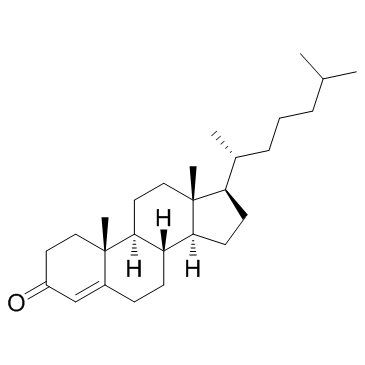
Cholest-4-en-3-one structure
|
Common Name | Cholest-4-en-3-one | ||
|---|---|---|---|---|
| CAS Number | 601-57-0 | Molecular Weight | 384.638 | |
| Density | 1.0±0.1 g/cm3 | Boiling Point | 482.7±12.0 °C at 760 mmHg | |
| Molecular Formula | C27H44O | Melting Point | 79-82 °C | |
| MSDS | N/A | Flash Point | 247.7±10.4 °C | |
Use of Cholest-4-en-3-oneCholestenone is the intermediate oxidation product of cholesterol. |
| Name | cholest-4-en-3-one |
|---|---|
| Synonym | More Synonyms |
| Description | Cholestenone is the intermediate oxidation product of cholesterol. |
|---|---|
| Related Catalog | |
| Target |
Human Endogenous Metabolite |
| References |
| Density | 1.0±0.1 g/cm3 |
|---|---|
| Boiling Point | 482.7±12.0 °C at 760 mmHg |
| Melting Point | 79-82 °C |
| Molecular Formula | C27H44O |
| Molecular Weight | 384.638 |
| Flash Point | 247.7±10.4 °C |
| Exact Mass | 384.339203 |
| PSA | 17.07000 |
| LogP | 9.36 |
| Vapour Pressure | 0.0±1.2 mmHg at 25°C |
| Index of Refraction | 1.519 |
Synonym:3-Oxo-4-cholesten Section 2 - COMPOSITION, INFORMATION ON INGREDIENTS
Risk Phrases: None Listed. Section 3 - HAZARDS IDENTIFICATION EMERGENCY OVERVIEW
The toxicological properties of this material have not been fully investigated. Potential Health Effects Eye: May cause eye irritation. Skin: May cause skin irritation. Ingestion: The toxicological properties of this substance have not been fully investigated. Inhalation: May cause respiratory tract irritation. The toxicological properties of this substance have not been fully investigated. Chronic: Not available. Section 4 - FIRST AID MEASURES Eyes: Flush eyes with plenty of water for at least 15 minutes, occasionally lifting the upper and lower eyelids. Get medical aid. Skin: Get medical aid. Flush skin with plenty of water for at least 15 minutes while removing contaminated clothing and shoes. Ingestion: Get medical aid. Wash mouth out with water. Inhalation: Remove from exposure and move to fresh air immediately. If not breathing, give artificial respiration. If breathing is difficult, give oxygen. Get medical aid. Notes to Physician: Section 5 - FIRE FIGHTING MEASURES General Information: As in any fire, wear a self-contained breathing apparatus in pressure-demand, MSHA/NIOSH (approved or equivalent), and full protective gear. Extinguishing Media: Use water spray, dry chemical, carbon dioxide, or chemical foam. Section 6 - ACCIDENTAL RELEASE MEASURES General Information: Use proper personal protective equipment as indicated in Section 8. Spills/Leaks: Vacuum or sweep up material and place into a suitable disposal container. Avoid generating dusty conditions. Section 7 - HANDLING and STORAGE Handling: Avoid breathing dust, vapor, mist, or gas. Avoid contact with skin and eyes. Storage: Store in a cool, dry place. Store in a tightly closed container. Section 8 - EXPOSURE CONTROLS, PERSONAL PROTECTION Engineering Controls: Use adequate ventilation to keep airborne concentrations low. Exposure Limits CAS# 601-57-0: Personal Protective Equipment Eyes: Wear appropriate protective eyeglasses or chemical safety goggles as described by OSHA's eye and face protection regulations in 29 CFR 1910.133 or European Standard EN166. Skin: Wear appropriate protective gloves to prevent skin exposure. Clothing: Wear appropriate protective clothing to prevent skin exposure. Respirators: Follow the OSHA respirator regulations found in 29 CFR 1910.134 or European Standard EN 149. Use a NIOSH/MSHA or European Standard EN 149 approved respirator if exposure limits are exceeded or if irritation or other symptoms are experienced. Section 9 - PHYSICAL AND CHEMICAL PROPERTIES Physical State: Solid Color: very slightly yellow Odor: Not available. pH: Not available. Vapor Pressure: Not available. Viscosity: Not available. Boiling Point: Not available. Freezing/Melting Point: 79 - 81 deg C Autoignition Temperature: Not available. Flash Point: Not available. Explosion Limits, lower: Not available. Explosion Limits, upper: Not available. Decomposition Temperature: Solubility in water: Specific Gravity/Density: Molecular Formula: C27H44O Molecular Weight: 384.64 Section 10 - STABILITY AND REACTIVITY Chemical Stability: Not available. Conditions to Avoid: Incompatible materials. Incompatibilities with Other Materials: Strong oxidizing agents. Hazardous Decomposition Products: Carbon monoxide, carbon dioxide. Hazardous Polymerization: Has not been reported. Section 11 - TOXICOLOGICAL INFORMATION RTECS#: CAS# 601-57-0: FZ7700000 LD50/LC50: Not available. Carcinogenicity: 4-CHOLESTEN-3-ONE - Not listed by ACGIH, IARC, or NTP. Other: See actual entry in RTECS for complete information. Section 12 - ECOLOGICAL INFORMATION Section 13 - DISPOSAL CONSIDERATIONS Dispose of in a manner consistent with federal, state, and local regulations. Section 14 - TRANSPORT INFORMATION IATA Not regulated as a hazardous material. IMO Not regulated as a hazardous material. RID/ADR Not regulated as a hazardous material. Section 15 - REGULATORY INFORMATION European/International Regulations European Labeling in Accordance with EC Directives Hazard Symbols: Not available. Risk Phrases: Safety Phrases: S 24/25 Avoid contact with skin and eyes. WGK (Water Danger/Protection) CAS# 601-57-0: No information available. Canada CAS# 601-57-0 is listed on Canada's NDSL List. CAS# 601-57-0 is not listed on Canada's Ingredient Disclosure List. US FEDERAL TSCA CAS# 601-57-0 is listed on the TSCA inventory. SECTION 16 - ADDITIONAL INFORMATION N/A |
CHEMICAL IDENTIFICATION
HEALTH HAZARD DATAACUTE TOXICITY DATAMUTATION DATA
|
| Hazard Codes | Xi |
|---|---|
| Risk Phrases | 36/37/38 |
| Safety Phrases | S22-S24/25 |
| WGK Germany | 3 |
| RTECS | FZ7700000 |
| HS Code | 29142900 |
| Precursor 9 | |
|---|---|
| DownStream 10 | |
| HS Code | 29142900 |
|---|
| CHOLESTENONE |
| 3-OXO-4-CHOLESTENE |
| (+)-4-Cholesten-3-one |
| Cholest-4-ene-3-one |
| 4-Cholesten-3-one |
| 3-Oxocholest-4-ene |
| EINECS 210-005-1 |
| 4-Cholestenone |
| MFCD00003663 |
| Cholest-4-en-3-one |
| 3-KETO-4-CHOLESTENE |
 CAS#:517-10-2
CAS#:517-10-2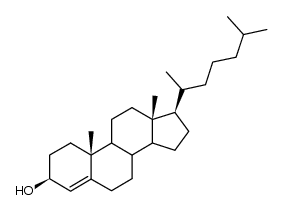 CAS#:566-90-5
CAS#:566-90-5 CAS#:601-53-6
CAS#:601-53-6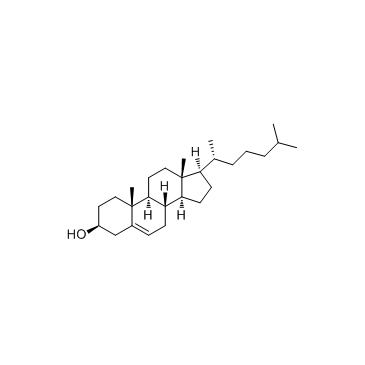 CAS#:57-88-5
CAS#:57-88-5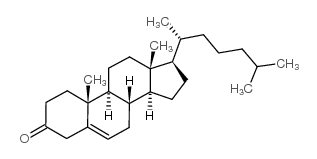 CAS#:601-54-7
CAS#:601-54-7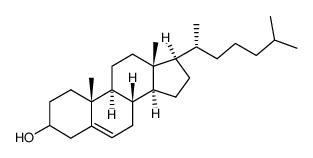 CAS#:765935-41-9
CAS#:765935-41-9 CAS#:78806-58-3
CAS#:78806-58-3 CAS#:566-88-1
CAS#:566-88-1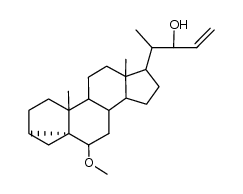 CAS#:57984-04-0
CAS#:57984-04-0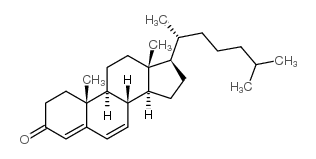 CAS#:566-93-8
CAS#:566-93-8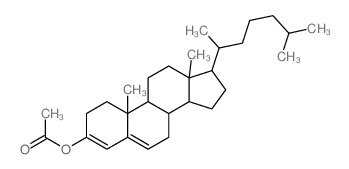 CAS#:2309-32-2
CAS#:2309-32-2![[[10,13-dimethyl-17-(6-methylheptan-2-yl)-1,2,6,7,8,9,11,12,14,15,16,17-dodecahydrocyclopenta[a]phenanthren-3-ylidene]amino]urea structure](https://image.chemsrc.com/caspic/083/20817-69-0.png) CAS#:20817-69-0
CAS#:20817-69-0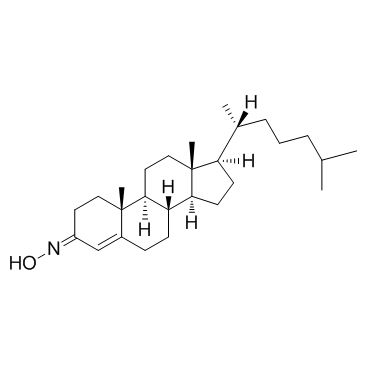 CAS#:22033-87-0
CAS#:22033-87-0![9-methoxy-4-nitrofuro[3,2-g]chromen-7-one structure](https://image.chemsrc.com/caspic/427/1975-34-4.png) CAS#:1975-34-4
CAS#:1975-34-4 CAS#:20988-50-5
CAS#:20988-50-5 CAS#:53-43-0
CAS#:53-43-0 CAS#:63-05-8
CAS#:63-05-8 CAS#:57-83-0
CAS#:57-83-0 CAS#:57701-41-4
CAS#:57701-41-4